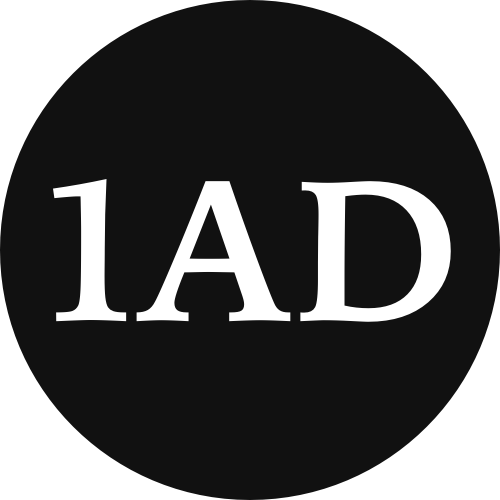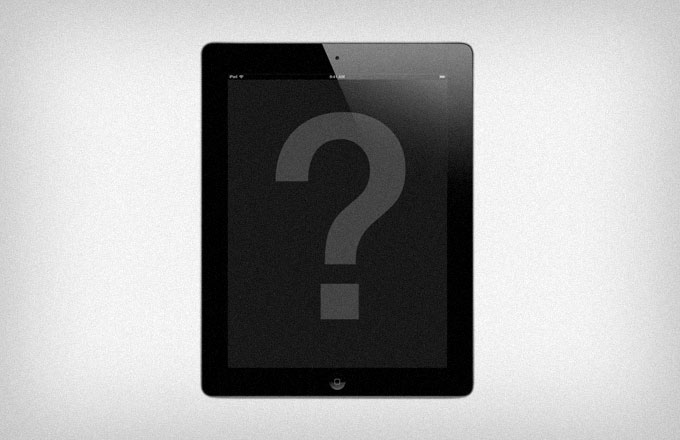 Unfortuantely, my plans to develop a simple Web- and app-based autism evaluation tool for concerned parents has hit a snag: the American Psychiatric Association denied my request to use their DSM criteria for autism as the basis for the tool. However, hope is not lost: I have some ideas about how I might incorporate other diagnostic criteria into the tool, and in the process make it an even more robust and interesting experience. It's not back to the drawing board, but onward and upward.
Unfortuantely, my plans to develop a simple Web- and app-based autism evaluation tool for concerned parents has hit a snag: the American Psychiatric Association denied my request to use their DSM criteria for autism as the basis for the tool. However, hope is not lost: I have some ideas about how I might incorporate other diagnostic criteria into the tool, and in the process make it an even more robust and interesting experience. It's not back to the drawing board, but onward and upward.
New Sensations
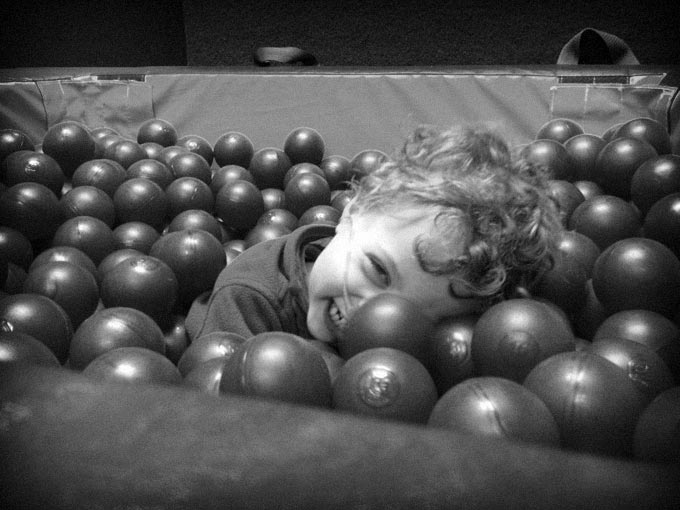 Today I took C to a sensory gym. His favorite activity, by far, was rolling around in the ball pit. It was truly joyous to see him so happy.
Today I took C to a sensory gym. His favorite activity, by far, was rolling around in the ball pit. It was truly joyous to see him so happy.
Visualizing the Autism Spectrum

What do you envision when someone says, "autism spectrum"?
Like most people, you probably imagine a line going from mild to severe, or good to bad, or something similar. At one end would be neurotypical (non-ASD), at the other severely autistic.
The problem is that's not how the spectrum works. I learned this when C was diagnosed and I, like any parent, wanted to find out where he was on this so-called spectrum. Was he in the middle? Toward the more severe end?
It wasn't that the experts couldn't or wouldn't answer me. It's that I was asking the wrong question. I wanted to be able to plot his autism on a linear scale, but the autism spectrum isn't linear at all.

So I did my own research to figure out what C's autism looked like. I felt like visualizing it would help me understand where his strengths and weaknesses were. However, several trips to Google left me more befuddled than ever: there wasn't any agreed-upon visualization of the autism spectrum.
Since I earn my living trying to make complex things simple and easy to understand, I decided to create my own autism spectrum diagram, something that would provide a more accurate representation of the condition.
I based my visualization on the fact that there are three generally accepted axes for ASD: social, communication, and behavioral.
On each axis, the range goes from typical — what we'd expect to see in a non-ASD individual — to severely impaired. Here are the generally accepted criteria for each axis:
Social Impairment
Problematic nonverbal behaviors; failure to interact appropriately with peers or make friends; playing alone while other children the same age approach each other, cooperate and imitate each other; problems sharing interests, achievements or pleasure with others; problems responding to social and emotional cues.
Communication Impairment
Delay or absence of speech with no attempt to compensate by using gestures; an inability to carry on a conversation even when speech is adequate; stereotyped and repetitive language; lack of imaginative play.
Repetitive Behaviors or Interests
An interest of intense or abnormal focus; rigid adherence to a routine or ritual that has no purpose; repetition of particular movements or gestures; persistent preoccupation with parts of objects.
My Visualization of the Spectrum
My diagram helps visually distinguish the three primary forms of ASD — Autistic Disorder, Asperger Synrdome, and PDD-NOS — from one another. (C has Autistic Disorder.)
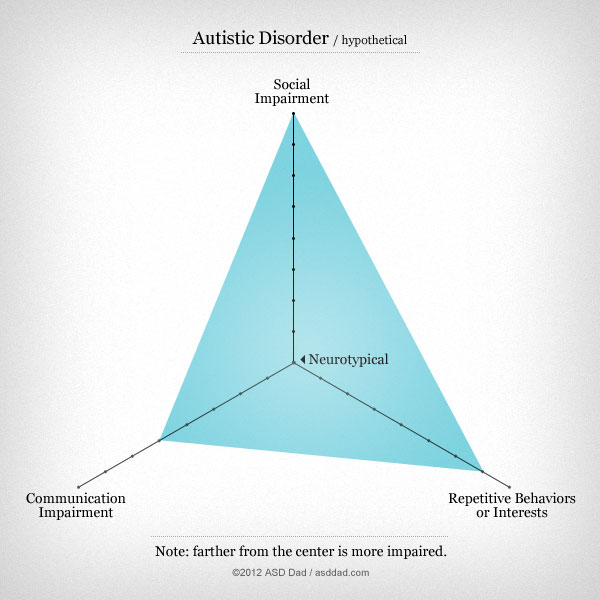


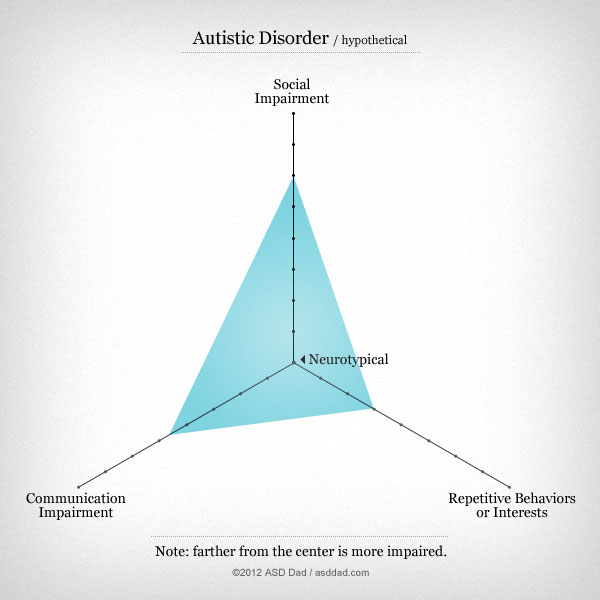
Plotting the level of impairment is subjective, of course, and one's point on each axis may change over time, with therapy and other treatments. Nonetheless, what my diagram shows is that the so-called autism spectrum doesn't result in a single point plotted on a line, but several points that create a shape, a map of each individual's unique ASD landscape.
Of course, the diagrams above are hypothetical, not based on any particular individual. In reality, each individual would map differently based on their own levels of impairment.
What Do You Think?
My diagram is a work in progress. I'm not formally educated in ASD, obviously, but I felt this format was helpful. What do you think? Let me know.
Feeling Appy
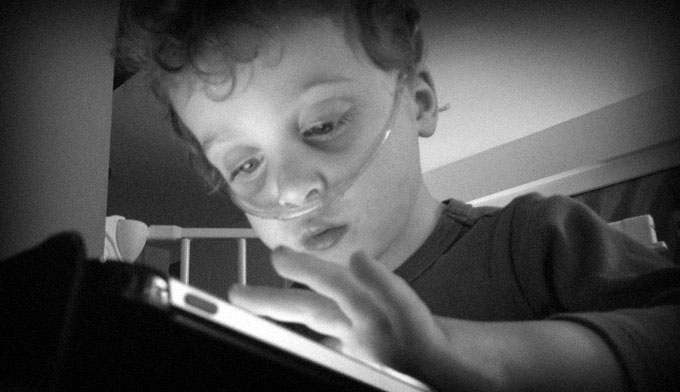 C's biggest obsession is letters and numbers: he sees them everywhere, and even though he just turned 3, he's already starting to spell words. (Some people have suggested he might have hyperlexia; I'm not convinced, though his interest and abilities are certainly unusual.)
C's biggest obsession is letters and numbers: he sees them everywhere, and even though he just turned 3, he's already starting to spell words. (Some people have suggested he might have hyperlexia; I'm not convinced, though his interest and abilities are certainly unusual.)
I should clarify: it's not so much spelling as it is repeating what we've told him. When he becomes fascinated by the letters in a specific word, such as the EXIT sign on our floor, we tell him what the word is. Now he spells it out ("E-X-I-T"), then proudly proclaims, "Exit!"
On the other hand, he is actually beginning to sound words out on his own, as when he recently read "C-U-X" (on an electrical box) and then said, "C-U-X...sounds like saxophone!"
Because he's not stimming out on letters, numbers, and words, we're encouraging this interest. When he became interested in trains, he would get so intense and obsessive that he would completely lose focus and ultimately have a monumental meltdown; we ultimately had to reduce the amount of interactions he had with train-related items.

I recently found a great iPad app called "Write My Name" that C loves. As the title suggests, he gets to write his name, as well as his brother's name; he also spells out other words, and traces every letter of the alphabet.
The app requires him to point and drag around the letter forms, which is a fine motor skill many ASD kids struggle with. While C can definitely lose himself in the game for extended periods of time, he doesn't disappear, and he doesn't become obsessive. It seems to offer just the right amount of stimulation.
I realize there are some experts who believe mechanical and, in specific, app-based tools are a no-no; the argument is that they reinforce self-stimulatory interactions with objects instead of actual interactions with people. I haven't found that to be the case. In fact, the best apps seem to build C's confidence, give him a larger understanding of his world, and they're helping to hone his cognitive and motor skills. Some of these apps actually focus on social interactions as well, but in a way that is less threatening than a direct interaction. It's as though they're beginning to build the bridge.
Much is being made of apps as a cure-all or miracle for the treatment of ASD. I don't know if that's the case. What I do know is that C enjoys the apps, and seems to be benefiting as well. For that, I'm grateful.
Wiped
 Sunday isn't a day of rest for C: he had four hours of ABA therapy, including a two-hour session with a brand new therapist; later, we went to the park and the big playground, where he ran around disconnected from his oxygen for over an hour. Later, we watched ducks and geese in the big pond, before coming home for dinner, baths, and bed.
Sunday isn't a day of rest for C: he had four hours of ABA therapy, including a two-hour session with a brand new therapist; later, we went to the park and the big playground, where he ran around disconnected from his oxygen for over an hour. Later, we watched ducks and geese in the big pond, before coming home for dinner, baths, and bed.
He's working so much, trying so hard, but it's paying off. Every day I see a little more of C emerge, and it's amazing.
